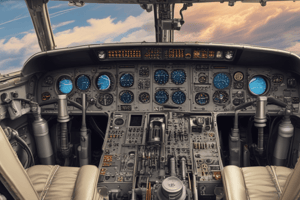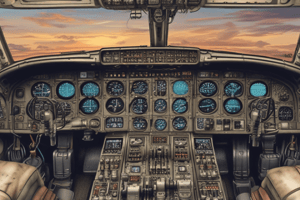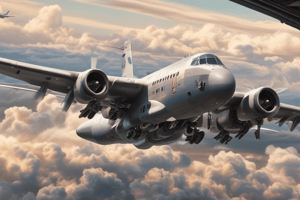Podcast
Questions and Answers
What is the primary purpose of the On-Board Maintenance System?
What is the primary purpose of the On-Board Maintenance System?
- To assist maintenance personnel in fault-finding of complex avionics systems (correct)
- To improve aircraft aerodynamics
- To monitor aircraft performance during flight
- To reduce the cost of aircraft maintenance
Which of the following systems is NOT part of the On-Board Maintenance System?
Which of the following systems is NOT part of the On-Board Maintenance System?
- Report printing system
- Data loading system
- Electronic flight instrument system (correct)
- Central Maintenance System
What is the main function of the Central Maintenance Computers (CMC) in the Central Maintenance System?
What is the main function of the Central Maintenance Computers (CMC) in the Central Maintenance System?
- To store maintenance data
- To enable the mechanic to extract maintenance data and initialise tests on aircraft systems (correct)
- To display aircraft performance data
- To control aircraft flight systems
What is the benefit of using the On-Board Maintenance System?
What is the benefit of using the On-Board Maintenance System?
What is the function of the Multipurpose Control and Display Units (MCDU) in the Central Maintenance System?
What is the function of the Multipurpose Control and Display Units (MCDU) in the Central Maintenance System?
What type of maintenance is supported by the On-Board Maintenance System?
What type of maintenance is supported by the On-Board Maintenance System?
What type of system is used in conjunction with the aircraft ECAM or EICAS cockpit display systems?
What type of system is used in conjunction with the aircraft ECAM or EICAS cockpit display systems?
What type of warnings are transmitted to the Central Maintenance Computer (CMC)?
What type of warnings are transmitted to the Central Maintenance Computer (CMC)?
What is the function of the CMC's Central Processing Unit (CPU)?
What is the function of the CMC's Central Processing Unit (CPU)?
What is included in the post or current flight report?
What is included in the post or current flight report?
What is stored in the CMC for the Previous Flight Report (PFR)?
What is stored in the CMC for the Previous Flight Report (PFR)?
What information is included in the data stored in the CMC?
What information is included in the data stored in the CMC?
What is a characteristic of Type 3 systems?
What is a characteristic of Type 3 systems?
What is the purpose of the Multifunction Control Display Unit (MCDU)?
What is the purpose of the Multifunction Control Display Unit (MCDU)?
Where are the data concerning all aircraft systems stored?
Where are the data concerning all aircraft systems stored?
What is the function of the Central Maintenance Computers (CMCs)?
What is the function of the Central Maintenance Computers (CMCs)?
How do Type 1, 2, and 3 systems send their BITE information?
How do Type 1, 2, and 3 systems send their BITE information?
What is the purpose of the CMS menu?
What is the purpose of the CMS menu?
What is the primary tool used to select and update system software in the Boeing 777 aircraft?
What is the primary tool used to select and update system software in the Boeing 777 aircraft?
What is the consequence of incorrect software loading procedures in aircraft operations?
What is the consequence of incorrect software loading procedures in aircraft operations?
Where can software downloads be initiated in an aircraft?
Where can software downloads be initiated in an aircraft?
What happens after the computer acknowledges the request from the MCDU for software downloading?
What happens after the computer acknowledges the request from the MCDU for software downloading?
What is the primary purpose of the data loader selector switch in the Airbus system?
What is the primary purpose of the data loader selector switch in the Airbus system?
Why are software and system functional and confidence checks performed after software loading?
Why are software and system functional and confidence checks performed after software loading?
What type of computer systems are typically used in Class 1 EFB systems?
What type of computer systems are typically used in Class 1 EFB systems?
What is required before Class 2 EFB systems can be used in an aircraft?
What is required before Class 2 EFB systems can be used in an aircraft?
Where are additional display units usually installed in the cockpit?
Where are additional display units usually installed in the cockpit?
What is the main difference between Class 1 and Class 2 EFB systems?
What is the main difference between Class 1 and Class 2 EFB systems?
What type of devices are Class 1 EFB systems considered?
What type of devices are Class 1 EFB systems considered?
Which document defines the classes of EFB hardware configurations?
Which document defines the classes of EFB hardware configurations?
Flashcards are hidden until you start studying
Study Notes
On-Board Maintenance Systems (OMS)
- OMS is designed to assist maintenance personnel in fault-finding of complex avionics systems, minimizing ground time and improving maintenance process efficiency.
- OMS consists of:
- Central Maintenance System (CMS)
- Data loading system
- Electronic library system
- Report printing system
Central Maintenance System (CMS)
- CMS enables mechanics to extract maintenance data concerning most aircraft systems and initialize tests on these systems.
- Main components of CMS:
- Central Maintenance Computers (CMC 1 and 2)
- Multipurpose Control and Display Units (MCDU 1, 2, and 3)
- CMS is used in conjunction with aircraft Electronic Centralised Aircraft Monitoring (ECAM) or Engine Indication and Crew Alerting System (EICAS) cockpit display systems.
Central Maintenance Computer (CMC)
- CMC receives primary and independent warnings or maintenance status type warnings from system BITEs.
- CMC correlates messages with aircraft parameters to amalgamate fault information with time, date, flight phase, etc.
- CMC stores maintenance data for retrieval, including:
- Leg heading, date, flight number, city pair from, start time, and A/C identification
- Warning messages transmitted ATA Sub ATA
- Calculated warning code and type
- CMC compiles a Previous Flight Report (PFR) by storing all ECAM and failure messages recorded during the 63 previous flight legs.
Multifunction Control Display Unit (MCDU)
- MCDU consists of a screen for data display, an alphanumeric keyboard, and line keys used to send commands to connected systems.
- MCDU provides access to data from the CMC system and allows testing of aircraft systems, including self-tests and guided tests for system fault-finding.
Data Loading
- Data loading is similar to loading software onto a home computer.
- Operator uses the Cursor Control Device (CCD) of the Maintenance Access Terminal (MAT) to select and update required system software.
- Correct software loads and configurations are critical to aircraft operations, and software mismatches can cause disastrous sequences of events.
Electronic Flight Bag (EFB)
- EFB is an electronic device used on flight decks to perform various tasks that previously required reference books, aeronautical charts, and mathematical calculations.
- The Civil Aviation Authorities define three EFB classes:
- Class 1: Portable, Commercial Off-the-Shelf (COTS)–based computer systems used for aircraft operations.
- Class 2: Portable, COTS-based computer systems used for aircraft operations, connected to aircraft power and mounting device on the flight deck.
Studying That Suits You
Use AI to generate personalized quizzes and flashcards to suit your learning preferences.




